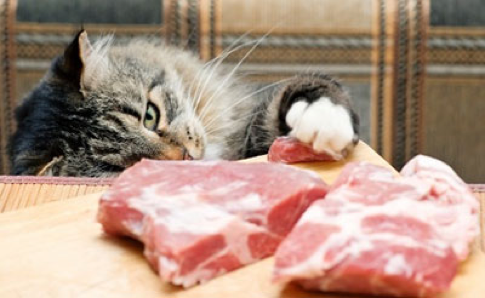Just What is the Raw Meat Diet,
Anyway?

All cats, small or large, are true carnivores, obligate carnivores. This means they must eat meat to survive. Cats cannot be vegetarians. Because they evolved to fill this top predator niche, their bodies are specifically geared for processing a prey-based diet. This is as true for a tiger as it is for the cat on your lap.
Raw feeding is a way to feed cats a more natural diet. By natural we mean bio-appropriate. A diet that fits their true nutritional requirements. The benefits to your cat are enormous. And it isn’t hard at all. Raw diets can be readily purchased frozen at the more enlightened pet stores, purchased online and delivered right to your door.
A Cat’s Diet in the Wild

Why should we pay attention to what a cat would eat in the wild? Because cats really aren’t domesticated. Humans haven’t changed cats much at all. We haven’t messed with their basic form and indeed value them for their wild abilities i.e. hunting rodents.
It is only recently that we have tried to feed cats a processed, carbohydrate filled diet. It is no coincidence that this same period also exhibited a dramatic increase in disease and obesity in cats.
In the wild, cats eat whole, raw prey. Their diet includes mice, rats, any other small rodents available, rabbits, insects, amphibians and birds. They usually eat the whole animal, meat, bones, brains, organs and fur. Their systems are uniquely set up to metabolize this diet which is high in moisture, high in protein and very low in carbohydrates. Because this is the diet they have relied upon for tens of thousands of years, they do not have the ability to process carbohydrates very well. Cats get most of their energy requirements from glucose their livers process from protein, not carbohydrates.¹ Not only are carbohydrates hard for your cat’s system to handle, but they are also detrimental to your cat’s health.² Think about that the next time you see pretty pictures of grains and vegetables on the front of a bag of commercial cat food.
Many of the nutrients cats need must come from animal sources. Arachidonic acid, an essential fatty acid, is found only in meat. Cats must consume preformed vitamin A from animal sources because, unlike dogs or humans, they do not have the ability to make it from plant derived beta carotene.³ Taurine is essential for cats and is only found in meat sources, not plants. A taurine deficiency can cause blindness and heart problems. Taurine is also found in high levels in insects.
What about Food Poisoning?
You might worry about salmonella. Of course salmonella is out there, but as with meat you would prepare for yourself, following safe handling practices minimizes the risk. Cats are very resistant to bacteria such as salmonella, which makes sense for an animal that evolved to exclusively eat raw meat. Their stomachs are much more acidic than a human’s. They have very short digestive tracts; shorter than any other comparably sized mammal. Food normally passes through their systems in about 12 hours. This doesn’t give bacteria enough time to proliferate and make the cat sick. Compare that to humans, where food takes 36-48 hours to pass through, and you can see why humans are much more susceptible to bacterial pathogens. Parasites are killed by freezing the food. Almost all recalls due to salmonella or other contamination in pet food involved canned or dry foods. A recall in 2007 that sickened about 78 people with salmonella was traced to dry pet food. Interestingly, none of the animals that ate it got sick.
Hodgkins, DVM: “If there can be no fundamental objection to the mere idea of raw meat as a diet for the cat, what legitimate objections might there be about the practical aspect of feeding raw meat to felines? The first objection would be the possibility of food poisoning from bacterial contamination of the meat. While this is certainly a possibility, just as food poisoning of humans who eat raw meat (I love sushi and sashimi!) is always at least a possibility, the reality is highly controllable and overstated, in my opinion and the opinion of many others. Human-grade ground and whole raw meats for pets are available today because of the growing popularity of the practice of among pet owners, such as Feline’s Pride. These meats are handled carefully by the processor, and frozen immediately after processing.”
A Healthy Alternative
Your cats are part of your family, and of course you want what is best for them. There is growing evidence that feeding dry food causes many of the diseases that cats are suffering from in ever larger numbers.⁷ Diet plays a huge role in the health of your animals, so choosing a diet that reflects what a cat would eat in the wild makes a lot of sense. Feeding a balanced raw diet is feeding a healthy diet. Cats’ systems are perfected to handle just this kind of food.
Raw diets, whether commercial or homemade, usually consist of ground meat, bone and organs, along with eggs, water and supplements. Ideally, your cat should also get some raw meaty bones, given whole. Some commercial raw diets include vegetable matter, but this is usually a very small amount of around 1-5%. Notice that grain is completely absent. Cats are not cows. Grain has no place in a cat’s diet. Dry food and low quality canned food are mostly grain. The goal is to get as close as we can to a prey based diet without having to resort to live prey.
Taking control of what goes into your pet is an empowering experience and very important for the wellbeing of your cat.